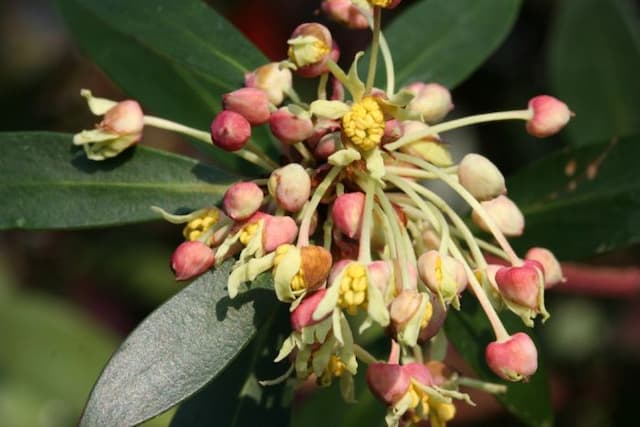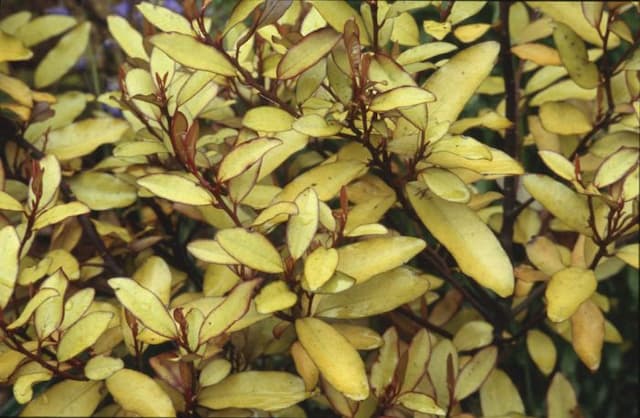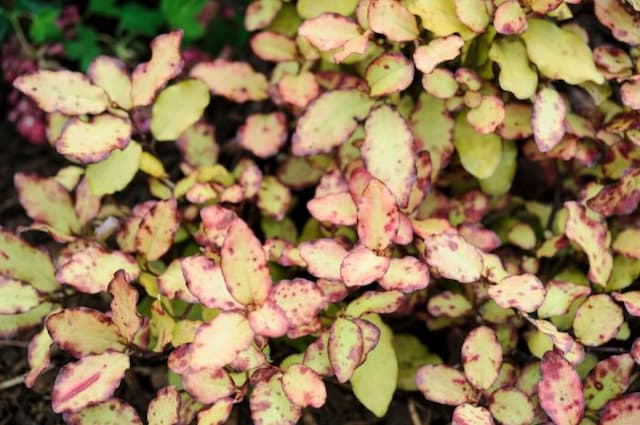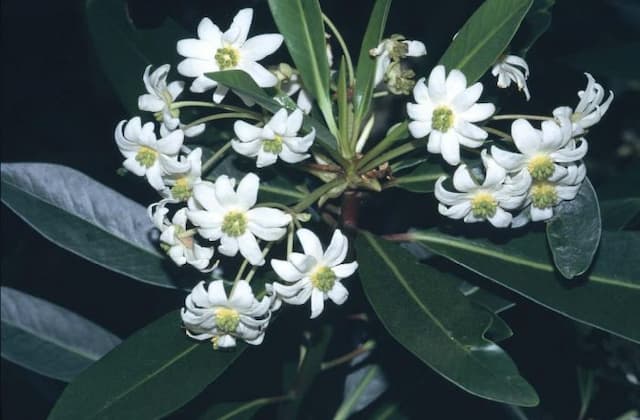Andean Pepperwort Drimys andina

ABOUT
The Drimys andina, also commonly known as the Magellan's barberry, is an evergreen plant distinguished by a lush, dense foliage that is rich green in color. Its leaves are leathery and have a glossy surface, giving them a vibrant appearance throughout the year. The edges of the leaves may appear slightly serrated, giving them a textured look. During the blooming season, the Magellan's barberry produces small, white flowers that are notably fragrant, attracting various pollinators to the plant. The flowers typically have a cluster formation, creating a striking contrast against the dark green leaves. Following the flowering period, the plant bears fruit that takes on a berry-like form. These fruits can range from a deep blue to black hue, adding another layer of visual interest to the shrub. Despite the omission of its size, the overall robust appearance of the Magellan's barberry contributes to its popular use as an ornamental plant in gardens.
About this plant
 Names
NamesSynonyms
Andean Horseradish, Canelo.
Common names
Drimys winteri var. andina, Tasmannia andina.
 Toxicity
ToxicityTo humans
The plant commonly known as Andean Pepper Tree (Drimys andina) is not widely known for its toxicity to humans. However, as with many plants, it is generally not advisable to ingest any part of this plant without proper knowledge of its effects. While specific toxic effects to humans have not been well-documented, consuming plant material that one is not familiar with could potentially lead to gastrointestinal upset or allergic reactions. Without definitive information on its toxicity, it is best to avoid ingesting parts of the Andean Pepper Tree.
To pets
The Andean Pepper Tree (Drimys andina) does not have a well-documented profile concerning toxicity to pets such as dogs and cats. While this plant is not commonly listed as a toxic plant to pets, the absence of clear information means that caution should be exercised. If a pet ingests parts of the Andean Pepper Tree, they could potentially experience gastrointestinal distress or other symptoms typical of plant poisoning, such as vomiting or diarrhea. If you suspect your pet has ingested this plant and is showing any signs of illness, it is advisable to consult a veterinarian.
 Characteristics
CharacteristicsLife cycle
Perennials
Foliage type
Evergreen
Color of leaves
Green
Flower color
White
Height
3-15 feet (0.9-4.6 meters)
Spread
3-6 feet (0.9-1.8 meters)
Plant type
Shrub
Hardiness zones
7
Native area
South America
Benefits
 General Benefits
General Benefits- Culinary uses: The leaves of Drimys andina, commonly known as the mountain pepper, can be used as a spice due to their peppery flavor.
- Garden ornamentation: With its glossy evergreen leaves and attractive appearance, mountain pepper can serve as an ornamental plant in gardens.
- Cultural significance: The mountain pepper may have cultural and historical importance in the regions where it naturally occurs, adding intangible value to landscapes and communities.
- Ecological role: As a native species, Drimys andina plays a part in its ecosystem, supporting local biodiversity by providing habitat and food for insects and animals.
- Resilience to pests: Mountain pepper may possess natural resistance to certain pests, reducing the need for chemical pesticides in the garden.
 Medical Properties
Medical PropertiesThis plant is not used for medical purposes.
 Air-purifying Qualities
Air-purifying QualitiesThis plant is not specifically known for air purifying qualities.
 Other Uses
Other Uses- Perfumery: The aromatic leaves of Drimys andina, commonly known as Andean Winter's Bark, can be used in the creation of perfumes and scented products.
- Insect Repellant: The aromatic properties of Andean Winter's Bark may deter certain insects when applied to the skin or used in sprays.
- Wood Carving: The wood of Andean Winter's Bark is sometimes used in woodworking for small craft items due to its fine grain and workability.
- Culinary Garnish: The aromatic leaves can be used to add a unique flavor and decoration to gourmet dishes.
- Floral Arrangements: Branches and leaves of Andean Winter's Bark can be used as a lasting green addition to floral displays.
- Traditional Rituals: In some indigenous cultures, parts of the plant may be used in rituals or ceremonies.
- Natural Dye: The bark contains tannins which can be used to produce a natural dye for textiles.
- Horticultural Training: The plant can be used for educational purposes in horticulture to teach about different plant species and their growth requirements.
- Essential Oils: The leaves and bark may be distilled to extract essential oils that can be used for aromatherapy.
- Fragrance Sachets: Dried leaves and bark can be placed in sachets to freshen up closets and drawers while imparting a pleasant smell.
Interesting Facts
 Feng Shui
Feng ShuiThe Drimys andina, commonly known as the Andean Winter's Bark, is not used in Feng Shui practice.
 Zodiac Sign Compitability
Zodiac Sign CompitabilityThe Andean Winter's Bark is not used in astrology practice.
 Plant Symbolism
Plant Symbolism- Healing and Protection: Drimys andina, commonly known as the Andean Pepper Tree, is thought to symbolize healing due to its medicinal properties, which have been traditionally used to treat various ailments.
- Purification: The plant can also represent purification, as it is often used in local rituals to cleanse spaces and people from negative energies.
- Resilience: Growing in challenging mountain climates, the Andean Pepper Tree is seen as a symbol of strength and the ability to withstand tough environments.
 Water
WaterChilean Winter's Bark should be watered deeply, allowing water to penetrate the soil to reach the roots. It's essential to let the soil dry out slightly between waterings, typically watering once every week to ten days, depending on the climate and soil drainage. During active growth in spring and summer, the plant may require more frequent watering, but always check the soil moisture before adding water. Provide about 1 to 2 gallons of water for medium-sized plants, ensuring that the water is distributed evenly around the base without splashing the foliage.
 Light
LightChilean Winter's Bark prefers to be placed in a location with bright, indirect light or partial shade. It can tolerate some morning sun but should be shielded from the intense afternoon sun to prevent leaf scorch. A spot that receives filtered sunlight for most of the day is ideal, helping to mimic its natural, forested habitat.
 Temperature
TemperatureChilean Winter's Bark can withstand a range of temperatures, with an ideal growth range between 50 to 70 degrees Fahrenheit. It can survive minimum temperatures down to about 20 degrees Fahrenheit but should be protected from prolonged freezing conditions. Keep it away from hot, dry winds and extreme heat, which can both cause stress to the plant.
 Pruning
PruningPrune Chilean Winter's Bark to maintain its shape and remove any dead or damaged branches. This is best done in late winter or early spring before new growth starts. Pruning can also be used to encourage bushier growth or to control the size of the plant if necessary. It is not necessary to prune frequently; an annual check-up and light trim are usually enough.
 Cleaning
CleaningAs needed
 Soil
SoilMagellan's Winter's Bark, or Drimys andina, thrives in well-draining, acidic soil with a pH of 5.5-6.5. A mix of peat, pine bark, and perlite in equal parts is ideal to ensure proper drainage and aeration. Regularly check soil moisture to maintain consistent conditions.
 Repotting
RepottingMagellan's Winter's Bark should be repotted every 2-3 years or when it outgrows its current pot. This will help to refresh the soil, prevent root-bound conditions, and support the plant's growth.
 Humidity & Misting
Humidity & MistingMagellan's Winter's Bark prefers high humidity levels, ideally between 50-70%. In drier climates, a regular misting or a pebble tray can help maintain optimal humidity around the plant.
 Suitable locations
Suitable locationsIndoor
Place Magellan's Winter's Bark in bright, indirect light with high humidity.
Outdoor
Plant in partial shade, shield from harsh sun, and protect from strong winds.
Hardiness zone
7-10 USDA
 Life cycle
Life cycleThe life cycle of Drimys andina, commonly known as the Magellan's peppertree, begins with seed germination, which requires a cool, moist environment often found in its native habitat of South American temperate forests. After germination, the seedling emerges and gradually develops into a young plant with a characteristic woody stem and leathery leaves. As the plant matures, it experiences a juvenile phase where it focuses on vegetative growth, gradually developing its root system and foliage without producing flowers. Following this phase, Drimys andina enters the reproductive stage, characterized by the production of small white flowers that are pollinated by insects, leading to the formation of berries that contain seeds. Once the berries ripen, they are dispersed by birds or gravity, allowing the seeds to spread in the environment and potentially germinate to begin a new cycle. Finally, after many years, the plant reaches its senescence stage, where growth slows and vegetative structures decline until the plant eventually dies, completing its life cycle.
 Propogation
PropogationPropogation time
Spring to Summer
Drimys andina, commonly known as the Andean pepper, is typically propagated from seeds. To do so, the seeds must be collected when fully ripe, which is generally in late summer or early fall. They are then sown in a cold frame as soon as they are ripe. Seeds can take a long time to germinate, often more than a year, and seedlings are prone to damping off. It's important to keep the seedlings well-ventilated to avoid this issue. Once they have grown large enough to handle, each seedling should be moved into its own pot and grown in cooler conditions until they are ready to be planted into their permanent positions. This usually occurs in the following spring or summer after the last expected frosts have passed.




